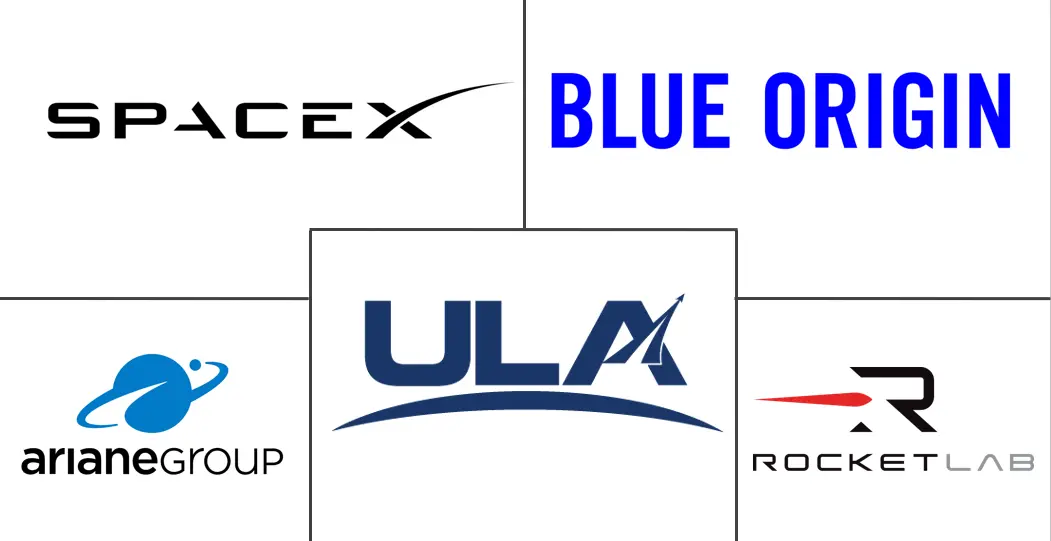Reusable Launch Vehicles Market Size and Share
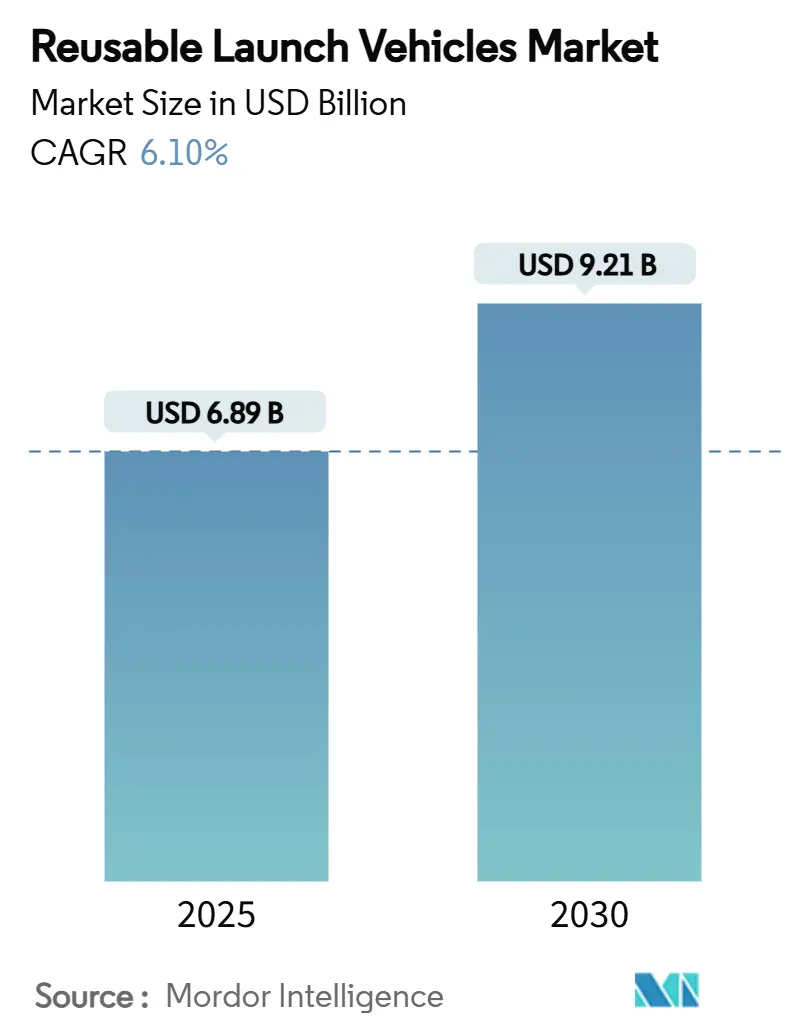
Reusable Launch Vehicles Market Analysis by Mordor Intelligence
The reusable launch vehicles market size is estimated at USD 6.89 billion in 2025 and is forecasted to hit USD 9.21 billion by 2030, expanding at a 6.1% CAGR. Growth stems from operators shifting away from expendable rockets toward hardware that can be recovered, refurbished, and reflown. Demonstrated booster life cycles of up to 40 missions with refurbishment costs below 10% of new‐build expenses have validated the economic upside. High-cadence constellation launches, steady government service contracts, and early demand for space tourism create persistent launch needs that favor assets capable of rapid turnaround. Manufacturing scale is improving as engine plants and vehicle assembly lines move toward automotive-style throughput, while gradual regulatory reforms shorten licensing timelines.
Key Report Takeaways
- By type, partially reusable systems held 83.54% of the reusable launch vehicles market share in 2024; fully reusable configurations post the fastest growth at an 18.78% CAGR to 2030.
- By configuration, two-stage-to-orbit vehicles captured 76.98% revenue share in 2024; single-stage-to-orbit designs are advancing at a 15.45% CAGR through 2030.
- By payload class, medium payloads accounted for 42.65% of the reusable launch vehicles market size in 2024, while heavy payload missions above 10,000 kg are set to expand at a 17.04% CAGR.
- By end user, the commercial segment led with 51.65% revenue share in 2024 and is expected to grow at a 14.56% CAGR.
- By application, satellite deployment dominated with a 67.22% share of the reusable launch vehicles market size in 2024; space tourism bookings are rising at a 20.45% CAGR.
- By geography, North America commanded 57.87% market share in 2024; Asia-Pacific is the fastest-growing region at a 15.64% CAGR.
Global Reusable Launch Vehicles Market Trends and Insights
Drivers Impact Analysis
| Driver | (~) % Impact on CAGR Forecast | Geographic Relevance | Impact Timeline |
|---|---|---|---|
| Cost-per-kg drop to less than USD 2,500 driven by booster reuse | +3.2% | Global, led by North America | Medium term (2-4 years) |
| Constellation boom demanding high-cadence launches | +2.8% | Global, concentrated in North America and Asia-Pacific | Short term (≤ 2 years) |
| Government and DoD multi-year service contracts | +2.1% | North America, expanding to allied nations | Medium term (2-4 years) |
| Emergence of heavy-lift fully reusable systems (Less than 100 tons) | +1.9% | North America, with Asia-Pacific following | Long term (≥ 4 years) |
| Venture-capital shift to "launch-on-demand" business models | +1.4% | Global, concentrated in North America and Europe | Medium term (2-4 years) |
| Certification of reused boosters for national-security payloads | +1.0% | North America, expanding to allied nations | Short term (≤ 2 years) |
| Source: Mordor Intelligence | |||
Cost-per-kg Drop to Less than USD 2,500 Driven by Booster Reuse
Reusable booster fleets are pushing average launch costs below the USD 2,500-per-kilogram threshold that once constrained many commercial missions. Marginal pricing falls as operators pivot to line-style engine production and standardized refurbishment procedures. These economics open new routes such as point-to-point cargo delivery and low-orbit logistics services that compete with premium air freight rates. Lower hardware emissions reinforce adoption by aligning with emerging environmental standards, creating a dual economic-sustainability benefit. The cost tipping point widens addressable demand across broadband, remote sensing, and in-space logistics.[1]Source: arXiv Authors, “Life-Cycle Emissions Comparison of Reusable and Expendable Rockets,” arxiv.org
Constellation Boom Demanding High-Cadence Launches
More than 400 commercial constellation projects are in various stages of build-out, yet fewer than one-fifth are actively launching. Each roll-out phase compresses into an 18- to 36-month window, forcing providers to seek vehicles able to fly weekly or even daily. Scheduled flights for national broadband networks and earth-observation arrays already exceed available slots on expendable rockets. Reusable fleets that can complete multiple missions per booster each month give operators both cost relief and schedule certainty, locking in launch contracts several years ahead.
Government and DoD Multi-Year Service Contracts
Long-term procurement awards from defense ministries and space agencies provide predictable cash flows that de-risk capital spending on reuse technologies. For instance, the US Department of Defense allocated USD 13.7 billion for national security launches through 2029, with certified providers expected to meet strict mission-assurance standards. Similar multi-year frameworks are appearing in allied nations, signaling a broader shift toward reuse as an accepted element of strategic space infrastructure.
Emergence of Heavy-Lift Fully Reusable Systems (≥ 100 t)
Next-generation launchers targeting 150 tons or more to low Earth orbit could eliminate multi-mission assembly campaigns by placing entire lunar or deep-space payload stacks on a single flight. Bringing both stages back for turnaround amplifies the cost leverage, but also demands new high-temperature materials, high-rate engine casting, and automated ground operations. Successful commercialization of heavy-lift reuse is expected to reshape planetary mission design, allowing space stations, depots, and surface cargo to launch ready-built.
Restraints Impact Analysis
| Restraint | (~) % Impact on CAGR Forecast | Geographic Relevance | Impact Timeline |
|---|---|---|---|
| Up-front capex and refurbishment infrastructure | -2.4% | Global, particularly acute in emerging markets | Medium term (2-4 years) |
| Safety-driven regulatory delays | -1.8% | Global, most severe in Europe and emerging markets | Short term (≤ 2 years) |
| Sparse domestic demand in Europe limits reuse economics | -1.2% | Europe, with spillover effects globally | Long term (≥ 4 years) |
| Spaceport environmental/community opposition | -0.9% | Global, concentrated in developed nations | Medium term (2-4 years) |
| Source: Mordor Intelligence | |||
Up-Front Capex and Refurbishment Infrastructure
High-volume reuse programs require specialized test bays, non-destructive evaluation labs, and cryogenic propellant handling cells, all of which push initial facility spending into the hundreds of millions of USD. Cash burn peaks years before flight revenue, challenging newcomers’ balance sheets. Mature players are mitigating this through vertically integrated engine shops and modular hangars that streamline inspection cycles, yet the barrier remains formidable for regions with fledgling launch markets.
Safety-Driven Regulatory Delays
Certification bodies built around expendable launch norms are still adapting licensing protocols for stages that land on drone ships, run back through hot-fire tests, and return to service within days. Environmental impact statements and neighborhood sound-level reviews lengthen approval timelines, particularly at new coastal spaceports. Smaller firms often lack the compliance staff required to manage multi-agency consultations, slowing their path to first flight and tilting near-term market share toward established incumbents.
Segment Analysis
By Type: Partial Reuse Anchors Today’s Fleet
Partially reusable boosters generated 83.54% of 2024 revenue, confirming that recovering the first stage captures most of a launch vehicle’s cost base. Reusability milestones—40 flights per Falcon 9 core, for example—support routine reflights with minor hardware swaps. The reusable launch vehicles market is thus dominated by operators that have optimized booster turnarounds to fewer than two weeks. Fully reusable architectures, however, are registering the highest 18.78% CAGR as technology demonstrators progress toward returning upper stages intact. Once thermal shielding and propellant-management hurdles are solved, end-to-end reuse may bring marginal launch costs close to propellant expense alone.[2]Source: Isaacson, “SpaceX Falcon 9 Economics,” inverse.com
Second-generation programs funded in 2025 underscore investor appetite: one fully reusable startup secured USD 260 million and booked a 2026 orbital debut. Established players are flight-testing belly-flop re-entry profiles and in-air stage grabs to shave turnaround times. As mass-production lines mature, the reusable launch vehicles market will likely see the cost curve bend further in favor of full reuse over partial schemes.
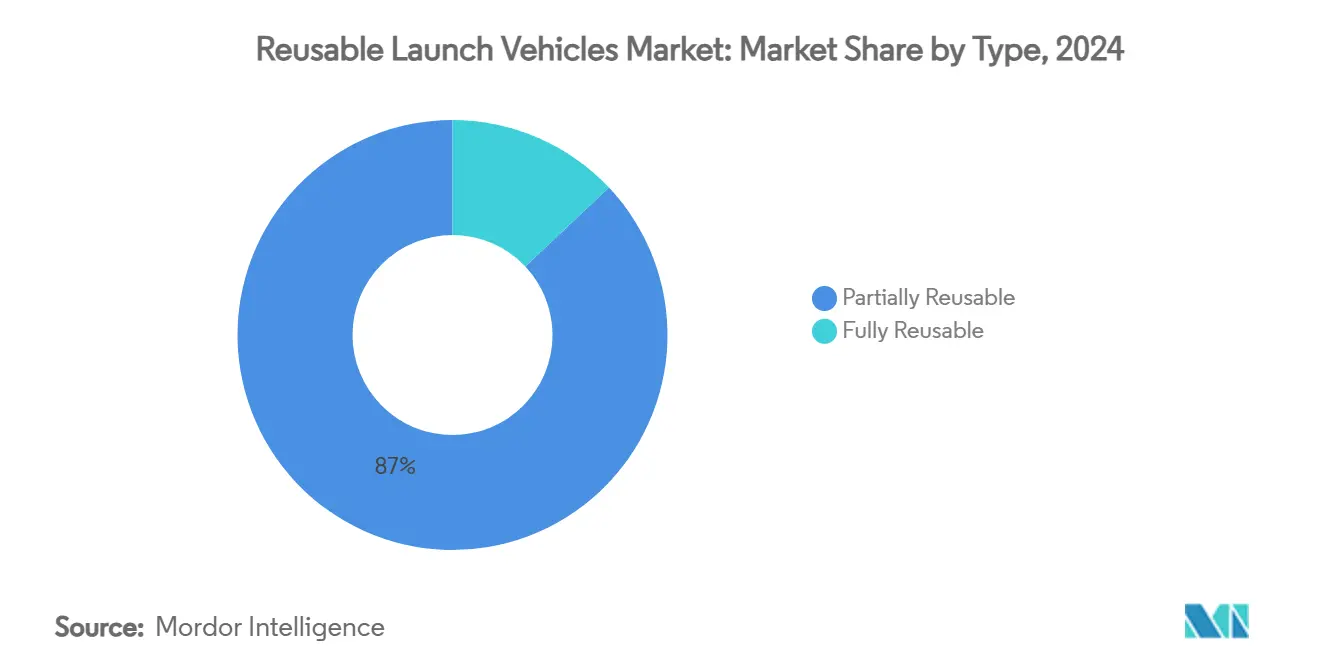
By Configuration: Two-Stage-to-Orbit Retains the Sweet Spot
Two-stage-to-orbit (TSTO) systems held a 76.98% share in 2024, reflecting a balance between aerodynamic margins and propulsion flexibility.[3]Source: Contest Technical Briefs, “Practical SSTO Concept,” techbriefs.com First-stage return consumes modest payload mass while upper stages remain expendable or are queued for future recovery trials. In contrast, single-stage-to-orbit (SSTO) approaches, though growing at a 15.45% CAGR, still wrestle with achieving acceptable payload fractions. Companies experimenting with advanced aerospike engines and lightweight composites illustrate the appeal—simple ground operations and a small vehicle count—yet must demonstrate that re-entry loads and propellant reserves do not erode commercial economics.
Expansion of engine thrust-to-weight ratios and high-efficiency closed-cycle designs could narrow the performance gap by the end of the decade. If SSTO prototypes validate durable heat-shield tiles and rapid refuel-and-go procedures, the reusable launch vehicle market could witness a second wave of architectural disruption.
By Payload Class: Heavy Missions Accelerate
Constellation batches and government surveillance spacecraft, medium-class launches (2,000–10,000 kg) controlled 42.65% of 2024 lift revenue. Vehicle portfolios are optimized around this range, producing a healthy launch cadence. Yet heavy cargo above 10,000 kg is advancing at a 17.04% CAGR as broadband operators consolidate satellites into larger, more capable buses and as space-station modules shift from multi-launch assembly to single-ship deliveries. Heavy-lift boosters expected online by 2027 promise reusable launch vehicles market size gains alongside mission architectures that leapfrog in-orbit construction.
Reusable designs scaling toward 150-250 tons to low Earth orbit will widen competitive moats for firms that mass-produce methane engines and stainless-steel tanks. Early booking of demonstration payloads signals that heavy-lift reuse may transition from prototype to commercial service within the forecast period.
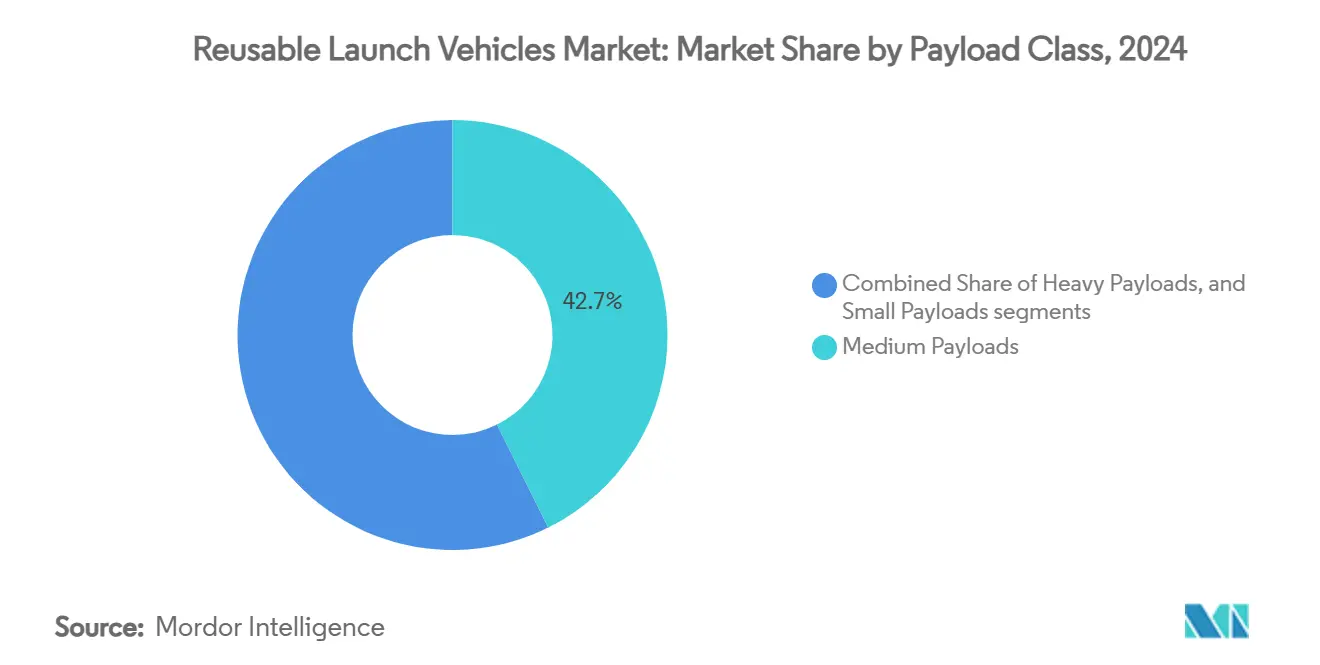
By End User: Commercial Demand Outpaces Institutional Programs
Commercial operators generated 51.65% of 2024 revenue and are poised for a 14.56% CAGR as vertical integration blurs lines between launch supply and space-based services. Coupling broadband networks or earth-observation revenue streams with captive launch fleets secures cash flow and hardware utilization. Governments still account for robust baseline demand through crewed ISS rotations, scientific probes, and defense payloads. However, fixed-price contracts and open competitions mean public agencies increasingly leverage the same reusable platforms, driving private growth.
Emerging national space programs in Asia and the Middle East are sourcing rides on commercial boosters to sidestep the steep capital bills of indigenous vehicles, reinforcing the commercial segment’s pull on the reusable launch vehicles market.
By Mission Application: Tourism Gains Momentum
Satellite deployment commanded 67.22% of sales in 2024, yet space tourism reservations are expanding at a 20.45% CAGR. Suborbital flights priced below USD 500,000 per seat and new orbital hotel concepts underpin recurring non-government human-spaceflight demand. Planned fleets of Delta-class winged craft aim for weekly operations by 2026, illustrating how dedicated vehicles can coexist with cargo-centric rockets. Should safety records remain strong, tourism-related lift requirements could transition from niche to mainstream by 2030.
Cargo resupply and in-space manufacturing remain steady, while lunar logistics and deep-space transportation are emergent niches that stand to benefit from large fully reusable ships set to debut later in the decade.
Geography Analysis
North America controlled 57.87% of 2024 revenue, anchored by mature launch pads, vertically integrated engine lines, and multi-billion-USD government launch contracts. Operators headquartered in the region recorded over half of global orbital flights, securing market leadership through demonstrable reflight statistics and rapid pad-turnaround capabilities. Export control rules channel allied military missions back to US providers, reinforcing a domestic backlog that sustains factory utilization.
Asia-Pacific is the fastest-growing geography at a 15.64% CAGR. Chinese commercial firms flight-tested booster landings in 2025, pairing domestic mega-constellation plans with coastal spaceport build-outs. India’s Next Generation Launch Vehicle program adopts recover-and-reuse plans, while private startups leverage cost-effective supply chains to build methane engines domestically. Japan, South Korea, and Australia are investing in equatorial launch pads and propellant depots, anticipating regional customer demand for low-inclination orbits.
Europe’s uptake of reusability is slower. Sparse institutional launch volumes and reliance on a single heavy-lift program constrain economies of scale needed to justify dedicated refurbishment facilities. New entrants pursuing mini-launchers with fold-out heat shields illustrate technical innovation, yet limited domestic payload pipelines hinder reuse rate economics. Policy efforts, including ESA’s reusability campaigns and public-private co-funding of test stands, aim to narrow the gap, but meaningful share gains may slip beyond 2030.
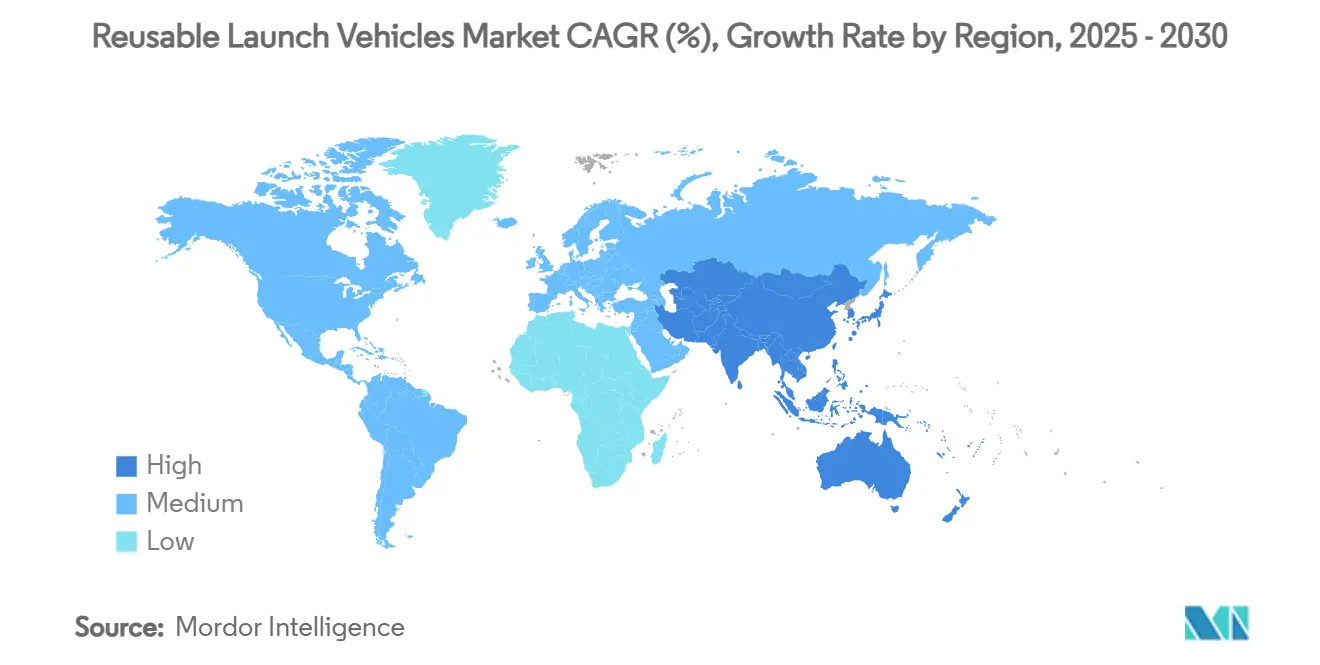
Competitive Landscape
Reusable launch services are presently concentrated, with one operator completing more than 130 orbital flights in 2024 and achieving up to 40 reuses per core. Proprietary engine supply, integrated satellite factories, and autonomous drone ship recovery provide a cost moat that newcomers must bridge. Rival heavy-lift boosters achieved maiden orbital insertion and quickly secured national security certification, ending the single-provider era for classified payloads and opening a multibillion-USD bidding pool.
Strategic moves emphasize vertical integration: a new USD 200 million engine plant in Alabama feeds two separate vehicle lines. At the same time, a Gulf Coast company named Gigabay aims to roll out a booster each day by 2028. Partnerships between rocket startups and automotive manufacturing groups seek to import lean production methods, lowering unit costs and raising flight cadence. Funding patterns show venture capital gravitating toward differentiated technologies—single-piece regeneratively cooled nozzles, full-flow staged-combustion engines, and propellant-agnostic avionics—that promise step-change refurbish cycles.
Capacity constraints remain the near-term bottleneck. Aggregate demand for constellation launches, lunar cargo and space tourism exceeds projected supply until at least 2028, giving incumbent providers strong pricing power even as new entrants ramp. Regulatory familiarity, proven landing telemetry, and fleet logistics experience create intangible barriers that supplement scale advantage. However, breakthroughs in additive-manufactured engines or rapid propellant densification could level the field for challengers by the next decade.
Reusable Launch Vehicles Industry Leaders
-
Space Exploration Technologies Corp.
-
Blue Origin Enterprises, L.P.
-
ArianeGroup SAS
-
United Launch Alliance, LLC
-
Rocket Lab USA, Inc.
- *Disclaimer: Major Players sorted in no particular order
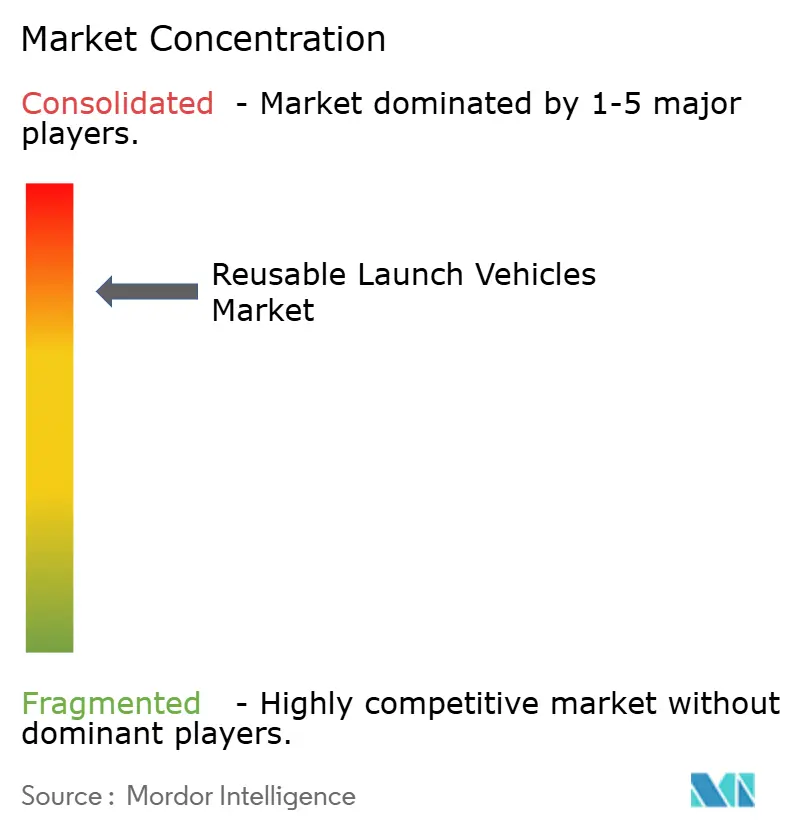
Recent Industry Developments
- March 2025: The US Space Systems Command’s Assured Access to Space (AATS) organization certified United Launch Alliance’s Vulcan launch system for National Security Space Launch missions. ULA is now eligible to launch NSSL missions after meeting 52 criteria, including 180 tasks, 2 flight demonstrations, and 114 audits.
- January 2025: Blue Origin’s New Glenn reached orbit on its NG-1 mission, validating first-stage recovery architecture and entering commercial service.
Global Reusable Launch Vehicles Market Report Scope
A space launch system designed to recover all or part of the system after deploying a satellite in orbit is termed a reusable launch vehicle (RLV). The primary objective of an RLV is to drive down the associative launch costs of the satellites by successfully recovering exhausted critical systems and components. To depict a comprehensive outlook, the study incorporates a detailed analysis of yearly satellite launches and the models of launch vehicles used for orbital deployment. The study also considers the ongoing R&D efforts divested by the market players to develop new RLV variants.
The reusable launch vehicles market is segmented based on type, configuration, and geography. By type, the market is segmented into partially reusable and fully reusable. By configuration, the market is segmented into single-stage and multi-stage. The report also covers the market sizes and forecasts for the reusable launch vehicles market in major countries across different regions. For each segment, the market size is provided in terms of value (USD).
| Partially Reusable |
| Fully Reusable |
| Single-Stage-to-Orbit (SSTO) |
| Two-Stage-to-Orbit (TSTO) |
| Multi-Stage (Booster-only reuse) |
| Small (Up to 2,000 Kg) |
| Medium (2,000 - 10,000 Kg) |
| Heavy (Above 10,000 Kg) |
| Commercial |
| Governments |
| Satellite Deployment |
| Cargo Resupply and In-Space Logistics |
| Human Spaceflight |
| Space Tourism |
| In-Space Manufacturing/Assembly |
| Deep-Space and Lunar Missions |
| North America | United States | |
| Canada | ||
| Mexico | ||
| Europe | Germany | |
| United Kingdom | ||
| France | ||
| Russia | ||
| Rest of Europe | ||
| Asia-Pacific | China | |
| Japan | ||
| India | ||
| Australia | ||
| Rest of Asia-Pacific | ||
| South America | Brazil | |
| Rest of South America | ||
| Middle East and Africa | Middle East | United Arab Emirates |
| Saudi Arabia | ||
| Rest of Middle East | ||
| Africa | South Africa | |
| Rest of Africa | ||
| By Type | Partially Reusable | ||
| Fully Reusable | |||
| By Configuration | Single-Stage-to-Orbit (SSTO) | ||
| Two-Stage-to-Orbit (TSTO) | |||
| Multi-Stage (Booster-only reuse) | |||
| By Payload Class | Small (Up to 2,000 Kg) | ||
| Medium (2,000 - 10,000 Kg) | |||
| Heavy (Above 10,000 Kg) | |||
| By End User | Commercial | ||
| Governments | |||
| By Mission Application | Satellite Deployment | ||
| Cargo Resupply and In-Space Logistics | |||
| Human Spaceflight | |||
| Space Tourism | |||
| In-Space Manufacturing/Assembly | |||
| Deep-Space and Lunar Missions | |||
| By Geography | North America | United States | |
| Canada | |||
| Mexico | |||
| Europe | Germany | ||
| United Kingdom | |||
| France | |||
| Russia | |||
| Rest of Europe | |||
| Asia-Pacific | China | ||
| Japan | |||
| India | |||
| Australia | |||
| Rest of Asia-Pacific | |||
| South America | Brazil | ||
| Rest of South America | |||
| Middle East and Africa | Middle East | United Arab Emirates | |
| Saudi Arabia | |||
| Rest of Middle East | |||
| Africa | South Africa | ||
| Rest of Africa | |||
Key Questions Answered in the Report
How large is the reusable launch vehicles market today?
The reusable launch vehicles market reached USD6.89 billion in 2025 and is projected to expand to USD 9.21 billion by 2030, expanding at a 6.1% CAGR. .
Which segment of the reusable launch vehicles market is growing the fastest?
Fully reusable vehicles represent the fastest-growing type, advancing at an 18.78% CAGR through 2030.
Why is Asia-Pacific considering a high-growth region?
China’s commercial rocket initiatives and India’s Next Generation Launch Vehicle program drive a 15.64% CAGR for Asia-Pacific, the highest regional rate.
What role do government contracts play in market growth?
Multi-year national security launch awards worth USD 13.7 billion provide stable revenue that underwrites ongoing investment in reusable systems.
How significant is space tourism for future demand?
Though still small, space tourism bookings are forecast to grow at a 20.45% CAGR, adding a new, recurring revenue stream for reusable boosters.
What is the chief barrier for new entrants?
High up-front capital for launch pads, engine production and refurbishment infrastructure remains the principal obstacle to market entry.
Page last updated on:
